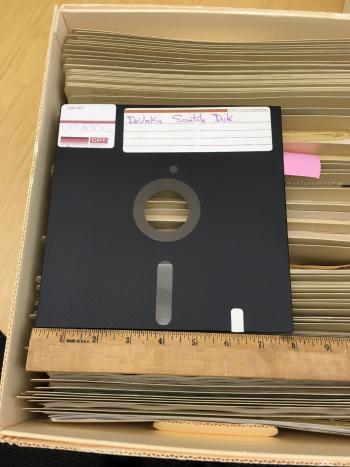 Sometimes you find something really intriguing when reviewing the electronic media in a collection of boxes at the Smithsonian Institution Archives. We frequently see CDs and DVDs. Sometimes we get 3.5” diskettes and occasionally a 5.25” floppy diskette. Recently, however, when reviewing a new accession (the David H. DeVorkin Papers, 1889-2011) the Archives’ Digital Services team came across an 8” floppy disk in a folder entitled, “Computer Use Committee: NASM Word Processing Project, 1980-1981”. For me, remembering that IBM introduced their first personal computer in 1981 triggered an interest in looking into this folder’s contents a little more.
Sometimes you find something really intriguing when reviewing the electronic media in a collection of boxes at the Smithsonian Institution Archives. We frequently see CDs and DVDs. Sometimes we get 3.5” diskettes and occasionally a 5.25” floppy diskette. Recently, however, when reviewing a new accession (the David H. DeVorkin Papers, 1889-2011) the Archives’ Digital Services team came across an 8” floppy disk in a folder entitled, “Computer Use Committee: NASM Word Processing Project, 1980-1981”. For me, remembering that IBM introduced their first personal computer in 1981 triggered an interest in looking into this folder’s contents a little more.
At the Archives, unfortunately, we do not have the equipment to read an 8” floppy disk, so we do not know what it contains. But, the paper documents within the folder tell an interesting story. In 1981, an Ad Hoc Computer Use Committee within the National Air and Space Museum (NASM) wanted to evaluate future computing processing needs at the museum. As part of this evaluation, a questionnaire was created and distributed throughout the various departments within the museum to survey their present and projected computer needs.
The questionnaire asked the museum departments to prioritize their needs in the following areas:
- Mailing lists
- Interactive systems for scheduling tours
- Stats on audience surveys and questionnaires
- General word processing
- Formatting and production of camera-ready copy
- Exhibit scripts and labels
- Personalized letters
- Loan program reports
- Inventory and accession files
- Graphics, charts and statistical reports
- Budget reports
- Associates charts
- Quarterly publications
The survey results highlighted the importance of word processing capabilities. Areas requiring computer functions, i.e. programmability, were seen as lower priority. A few of the museum’s departments did identify the need for computers to provide “electronic mail”, collections cataloging, information retrieval by researchers and visitors, and inventories, but the bulk of the response was for word processing functions. Obviously, only a few back in 1981 thought that email and computers in general would become such an integral part of everyday life.
According to the documents in the folder, at the time of the survey, NASM had a centralized word processing system with a small number of trained operators. (In 1981, I remember word processing was done in secretarial pools with IBM Selectric typewriters and magnetic card readers.) The Status Report of the Ad Hoc Compute Use Committee concluded that the basic word processing needs of the museum were currently being met by the existing system and that there was no need to expand the word processing capacity within the museum. A memo by Mr. DeVorkin concluded that more training was needed regarding the capabilities of word processing and that more staff should be trained to use the existing system. As more departments created more need for word processing, additional equipment might be needed.
Advance 35 years to 2016: Everyone has a computer on his/her desk. Individuals now generate huge amounts of data, spreadsheets, photos, drawings, videos, audio files, presentations, and email. And this does not begin to include the effect of the internet, social networks and smart phones on the amount, type and volume of work being conducted. My, how times have changed!
As a little background information, I did a quick search online on the history of personal computers. The personal computer was introduced as early as 1975.
- 1975 – Altair 8800 and IMSAI 8080
- 1976 – Apple I and the 5.25” floppy drive
- 1977 – Apple II and TRS 801980 – VIC-20 and Apple III
- 1981 – Osborne 1, Epson HX-20 and IBM PC
- From 1981 on, the history has been fast and furious.
Along with the developments of the computer, external storage media technologies also developed quickly. 8” paper sided floppy disks were available in the late 1960s and the 5.25” paper sided floppy disks became available in the mid 1970’s.Throughout the 80s the 5.25” floppy slowly replaced the 8” disk, although the smaller disk was still seen as physically too large. During the 80s other disk formats were developed and by the mid to late 80s the 3.5” plastic-sided disk replaced the 5.25” floppy.
When the Compact Disc (CD) was introduced in the early 1980s, it was first intended for music as a substitute for vinyl long playing (LP) albums. In the 90s, the CD was adapted for use as data storage and slowly replaced the 3.5” floppy disk. Though some computer designs still included a 3.5” drive, by the early 2000’s computer manufacturers started eliminating the 3.5” drive. Today’s computers have CD/DVD drives and USB connections for external disk drives. There are external disk drives for 5.25” and 3.5” floppies.
At the Archives we use these external drives to copy data from floppy disks we receive in our collections. It boggles the mind to think of the rapid technology advancements over the last 35 years and what might be coming in the next 35.
Related Resources
The History of Email at the Smithsonian, The Bigger Picture, Smithsonian Institution Archives
5.25” floppies: All Is Not Lost, The Bigger Picture, Smithsonian Institution Archives
Timeline of Computer History, Computer History Museum
Produced by the Smithsonian Institution Archives. For copyright questions, please see the Terms of Use.

Leave a Comment